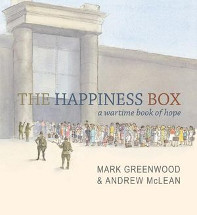The happiness box by Mark Greenwood

Ill. Andrew MacLean, Walker Books, 2018. ISBN 9781925081381
(Ages: 6+) Highly Recommended. Themes: War. Prisoners of war.
Children in war. World War Two. Changi Prison (Singapore). Sgt
Griffiths (Griff) was a prisoner of war, detained by the Japanese
for three years in Selarang Barracks and then the notorious Changi
Prison on Singapore Island, the aftermath of a terrible defeat for
the Australian Imperial Force in 1942.
Here he watched the children and women of Singapore marched into the
prison and as Christmas approached he wondered what sort of
Christmas these children would have. He and other prisoners than
used every scrap they could find to make presents for the children,
and Griff began to write a story, one that encapsulated hope and
happiness. The story revolved around three animals and another of
his peers, Captain Greener, illustrated the book. But when it was
inspected by the Japanese General, he rejected it saying it held
secret messages. It was to be destroyed. Another of the prisoners
took it to get rid of it, instead burying it and at the end of the
war it was dug up, a little worse for wear, but impressive in its
hope for peace and happiness for the imprisoned children.
It was published in 1947 and again in 1991, the original now held at
the State Library of New South Wales, where it was part of a touring
exhibition in 2007.
Greenwood's story of this book is inspirational, showing the
survival mechanisms of people entrapped by war. Despite their
appalling situation, the men were involved in helping the children
of the camp, offering them solace and hope in the midst of
unimaginable suffering and despair. That the book survived is
another story that resonates hope, and it has become an icon in its
own right.
MacLean's pen and watercolour illustrations rely on a palette of
browns and greys, ochres and greens to reflect the sombre, dreary
nature of everyday life in the prison. There is no variance, no
colour, no hope, except for the toys being made and the colours used
to illustrate the book. The contrast is outstanding and underscores
the belief that life will go on, that colour will return.
Behind the story of the book, readers will see the life led by the
POW's and the women and children within these walls. MacLeans'
illustrations realistically evoke the times with drawings of the men
lying on their bamboo bunks, or watching over the walls towards the
barracks, or being taken away to assured death working on the Burma
Railway. Biographies of the author and the illustrator of The
happiness box are given at the end, alongside a brief history
of the book itself, and a bibliography encouraging readers to
further research the story.
This book offers a fresh approach for classes to look at Australia's
involvement in World War Two and the affects of war on children.
Fran Knight